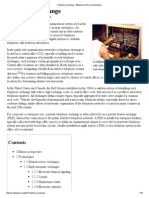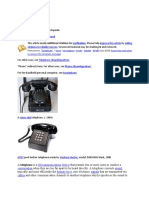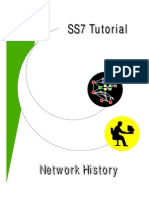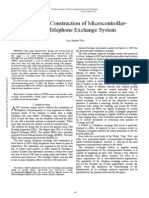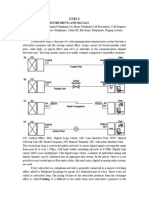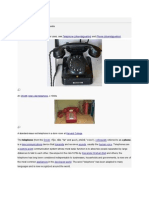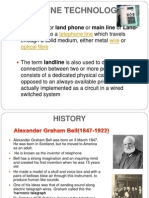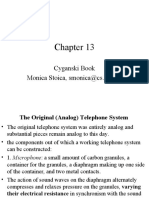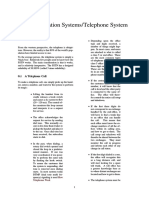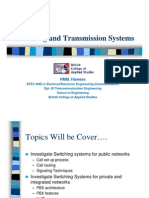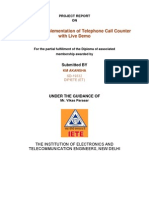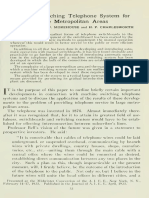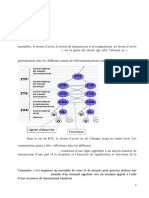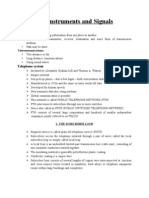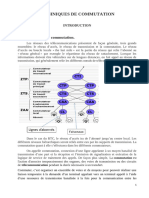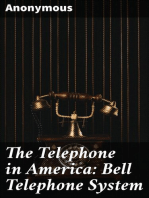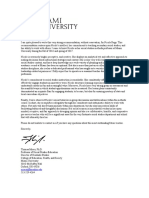Telephone Switch/ Telephone Exchange
Telephone Switch/ Telephone Exchange
Uploaded by
Edward Sevilla Dela CruzCopyright:
Available Formats
Telephone Switch/ Telephone Exchange
Telephone Switch/ Telephone Exchange
Uploaded by
Edward Sevilla Dela CruzOriginal Title
Copyright
Available Formats
Share this document
Did you find this document useful?
Is this content inappropriate?
Copyright:
Available Formats
Telephone Switch/ Telephone Exchange
Telephone Switch/ Telephone Exchange
Uploaded by
Edward Sevilla Dela CruzCopyright:
Available Formats
Edward Mishael S.
Dela Cruz BS-ECE 4-1 2008-20041 ECE 164 - Wire Communications TELEPHONE SWITCH/ TELEPHONE EXCHANGE In the field of telecommunications, a telephone exchange or telephone switch is a system of electronic components that connects telephone calls. A central office is the physical building used to house inside plant equipment including telephone switches, which make telephone calls "work" in the sense of making connections and relaying the speech information. The term exchange area can be used to refer to an area served by a particular switch, but is typically known as a wire center in the US telecommunications industry. The exchange code or Central Office Code refers to the first three digits of the local number (NXX). It is sometimes confused with the area code (NPA). In the United States, local exchange areas together make up a legal entity called local access and transport areas (LATA) under the Modification of Final Judgment (MFJ). HISTORY OF TELEPHONE SWITCHING Calling someone on the telephone is possible because of the use of what communications engineers call switching technology. The numbers on a telephone keypad relay information to a device much like a computer, which uses the numbers to direct your call to the appropriate destination. The first telephone switching technology was the manual switchboard. A switchboard was usually a board or box where all the telephone lines in a local area terminated. At the terminal points, plugs were installed so that wires could be connected between any two lines. When a customer placed a call, a light, bell, or other signal alerted the operator, who answered the call. The operator asked the caller whom they wanted to call, and used wires to connect the caller and the callee. The first commercial switchboard opened in 1878 to serve the 21 telephone customers in New Haven, Connecticut.
Women telephone operators using a manual switchboard in Montrose, Colorado, around 1915. Courtesy: Denver Public Library.
A Research on Telephone Switching
Telephone switchboards grew larger and more elaborate as more and more people got telephones in the late 19th century. They also began to be designed with more and more features, such as bells or lights that told the operator when a line was busy. There were so many telephone subscribers by about 1910 that inventors and telephone companies around the world began to look for ways to make telephone switching automatic. The most famous of the independent inventors was Almon Strowger. On 12 March 1889 in Kansas City, Missouri, he applied for a patent on a system of automatic telephone switching; the patent was granted on 10 May 1891. It was the first such system to meet with commercial success, being first implemented in La Porte, Indiana in 1892. But the automatic switching he invented was not perfected for nearly a decade. After the turn of the century, Strowger switches and dial telephones became common in independent (non-Bell) telephone exchanges in the United States. But it was only in 1919 that the American Telephone and Telegraph (AT&T) began giving customers in its Bell System exchanges telephones with dials on them, and installing automatic switching equipment in its central offices. It took decades to complete the conversion, one exchange at a time. While all telephones in Manhattan had dials by 1930, The last manual Bell telephones, on Catalina Island, California, were retired only in 1978. A dial telephone sent electric pulses down the line to the central switch, where they were detected and used to establish a connection automatically. Most areas of the United States had automatic switching and dial telephones by about 1950, and operators were only necessary for longdistance calls. These, too, were mostly automated by about 1965. Most automatic switching equipment used electromechanical apparatus to route calls and make connections until the 1960s, when transistors replaced the relays. And dial telephones themselves were replaced by touch tone phones with keypads. The first touch tone phones, which used musical tones instead of pulses, entered service in 1963. The transistor was invented at AT&T when engineers were looking for a replacement for the electromechanical relay. Engineers working on the first computers were also interested in telephone switching equipment, because the switching processes of computing were similar to automatic telephone switching. The term switchboard is not used today, but has been replaced by switch. Todays telephone switches come in many different varieties to serve local, longdistance, international, satellite, and cellular telephone needs in addition to digital data.
A Research on Telephone Switching
Manual service exchanges
1924 PBX switchboard With manual service, the customer lifts the receiver off-hook and asks the operator to connect the call to a requested number. Provided that the number is in the same central office, the operator connects the call by plugging into the jack on the switchboard corresponding to the called customer's line. If the call is to another central office, the operator plugs into the trunk for the other office and asks the operator answering (known as the "inward" operator) to connect the call. Most urban exchanges were common-battery, meaning that the central office provided power for the telephone circuits, as is the case today. In common-battery systems, the pair of wires from a subscriber's telephone to the switch (or manual exchange) carry -48VDC (nominal) from the telephone company end, across the conductors. The telephone presents an open circuit when it ison-hook or idle. When the subscriber goes off-hook, the telephone puts a DC resistance short across the line. In manual service, this current flowing through the off-hook telephone flows through a relay coil actuating a buzzer and lamp on the operator's switchboard. The buzzer and lamp would tell an operator the subscriber was off-hook (requesting service). In the largest U.S. cities, it took many years to convert every office to automatic equipment, such as panel switches. During this transition period, it was possible to dial a manual number and be connected without
A Research on Telephone Switching
requesting an operator's assistance. This was because the policy of the Bell System was that customers should not need to know whether they were calling a manual or automated office. If a subscriber dialed a manual number, an inward operator would answer the call, see the called number on a display device, and manually connect the call. For instance, if a customer calling from TAylor 4725 dialed a manual number, ADams 1233, the call would go through, from the subscriber's perspective, exactly as a call to LEnnox 5813, in an automated exchange. In contrast to the common-battery system, smaller towns with manual service often had magneto, or crank, phones. Using a magneto set, the subscriber turned a crank to generate ringing current, to gain the operator's attention. The switchboard would respond by dropping a metal tab above the subscriber's line jack and sounding a buzzer. Dry cell batteries (normally two large "No 6" cells) in the subscriber's telephone provided the DC power for conversation. Magneto systems were in use in one American small town, Bryant Pond, Woodstock, Maine as late as 1983. In general, this type of system had a poorer call quality compared to common-battery systems. Many small town magneto systems featured party lines, anywhere from two to ten or more subscribers sharing a single line. When calling a party, the operator would use a distinctive ringing signal sequence, such as two long rings followed by one short. Everyone on the line could hear the rings, and of course could pick up and listen in if they wanted. On rural lines which were not connected to a central office (thus not connected to the outside world), subscribers would crank the correct sequence of rings to reach their party. Early automatic exchanges
A rural telephone exchange building in Australia Automatic exchanges, or dial service, came into existence in the early 1900s. Their purpose was to eliminate the need for human telephone operators. Before the exchanges became automated, operators had to
A Research on Telephone Switching
complete the connections required for a telephone call. Almost everywhere, operators have been replaced by computerized exchanges. A telephone switch is the brains of an automatic exchange. It is a device for routing calls from one telephone to another, generally as part of the public switched telephone network. The local exchange automatically senses an off hook (tip) telephone condition, provides dial tone to that phone, receives the pulses or DTMF tones generated by the phone, and then completes a connection to the called phone within the same exchange or to another distant exchange. The exchange then maintains the connection until a party hangs up, and the connection is disconnected. This tracking of a connection's status is called supervision. Additional features, such as billing equipment, may also be incorporated into the exchange. In Bell System dial service, a feature called automatic number identification (ANI) was implemented. ANI allowed services like automated billing, toll-free 800-numbers, and 9-1-1 service. In manual service, the operator knows where a call is originating by the light on the switchboard's jack field. In early dial service, ANI did not exist. Long distance calls would go to an operator queue and the operator would ask the calling party's number, then write it on a paper toll ticket. See also Automatic Message Accounting. Early exchanges used motors, shaft drives, rotating switches and relays. In a sense, switches were relay-logic computers. Some types of automatic exchanges were Strowger (also known as Step-By-Step), All Relay, X-Y, Panel and crossbar. These are referred to collectively aselectromechanical switches. Electromechanical signaling Circuits connecting two switches are called trunks. Before Signaling System 7, Bell System electromechanical switches in the United States communicated with one another over trunks using a variety of DC voltages and signaling tones. It would be rare to see any of these in use today. Some signaling communicated dialed digits. An early form called Panel Call Indicator Pulsing used quaternary pulses to set up calls between a panel switch and a manual switchboard. Probably the most common form of communicating dialed digits between electromechanical switches was sending dial pulses, equivalent to
A Research on Telephone Switching
a rotary dial's pulsing, but sent over trunk circuits between switches. In Bell System trunks, it was common to use 20 pulse-per-second between crossbar switches and crossbar tandems. This was twice the rate of Western Electric/Bell System telephone dials. Using the faster pulsing rate made trunk utilization more efficient because the switch spent half as long listening to digits. DTMF was not used for trunk signaling. Multi-frequency (MF) was the last of the pre-digital methods. It used a different set of tones sent in pairs like DTMF. Dialing was preceded by a special key pulse (KP) signal and followed by a start (ST). Variations of the Bell System MF tone scheme became a CCITT standard. Similar schemes were used in the Americas and in some European countries including Spain. Digit strings between switches were often abbreviated to further improve utilization. For example, one switch might send only the last four or five digits of a telephone number. In one case, seven digit numbers were preceded by a digit 1 or 2 to differentiate between two area codes or office codes, (a two-digit-per-call savings). This improved revenue per trunk and reduced the number of digit receivers needed in a switch. Every task in electromechanical switches was done in big metallic pieces of hardware. Every fractional second cut off of call set up time meant fewer racks of equipment to handle call traffic. Examples of signals communicating supervision or call progress include E and M signaling, SF signaling, and robbed-bit signaling. In physical (not carrier) E and M trunk circuits, trunks were four wire. Fifty trunks would require a hundred pair cable between switches, for example. Conductors in one common circuit configuration were named tip, ring, ear (E) and mouth (M). In two-way trunks with E and M signaling, a handshake took place to prevent both switches from colliding by dialing calls on the same trunk at the same time. By changing the state of these leads from ground to -48 volts, the switches stepped through a handshake protocol. Using DC voltage changes, the local switch would send a signal to get ready for a call and the remote switch would reply with an acknowledgment to go ahead with dial pulsing. This was done with relay logic and discrete electronics. These voltage changes on the trunk circuit would cause pops or clicks that were audible to the subscriber as the electrical handshaking stepped through its protocol. Another handshake, to start timing for billing purposes, caused a second set of clunks when the called party answered. A second common form of signaling for supervision was called single-frequency or SF signaling. The most common form of this used a steady 2,600 Hz tone to identify a trunk as idle. Trunk circuitry hearing a 2,600 Hz tone for certain duration would go idle. (The duration requirement reduced falsing). Some
A Research on Telephone Switching
systems used tone frequencies over 3,000 Hz, particularly on SSB frequency division multiplex microwave radio relays. On Tcarrier digital transmission systems, bits within the T-1 data stream were used to transmit supervision. By careful design, the appropriated bits did not change voice quality appreciably. Robbed bits were translated to changes in contact states (opens and closures) by electronics in the channel bank hardware. This allowed direct current E and M signaling, or dial pulses, to be sent between electromechanical switches over a digital carrier which did not have DC continuity. Sounds A characteristic of electromechanical switching equipment is that the maintenance staff could hear the mechanical clattering of Strowgers, panel switches or crossbar relays. Most Bell System central offices were housed in reinforced concrete buildings with concrete ceilings and floors. In rural areas, some smaller switching facilities, such as Community, were sometimes housed in prefabricated metal buildings. These facilities almost always had concrete floors. The hard surfaces reflected sounds. During heavy use periods, it could be difficult to converse in a central office switch room due to the clatter of calls being processed in a large switch. For example, on Mother's Day in the US, or on a Friday evening around 5pm, the metallic rattling could make raised voices necessary. For wire spring relay markers these noises resembled hail falling on a metallic roof. On a pre-dawn Sunday morning, call processing might slow to the extent that one might be able to hear individual calls being dialed and set up. There were also noises from whining power inverters and whirring ringing generators. Some systems had a continual, rhythmic "clack-clack-clack" from wire spring relays that made reorder (120 ipm) and busy (60 ipm) signals. In Bell System installations, there were typically alarm bells, gongs, or chimes. These would annunciate alarms calling attention to a failed switch element. Another noisemaker: a trouble reporting card system was connected to switch common control elements. These trouble reporting systems would puncture cardboard cardswith a code that logged the nature of a failure. Remreed technology in Stored Program Control exchanges finally quieted the environment.
A Research on Telephone Switching
Maintenance tasks The maintenance of electromechanical systems was partly DC electricity and partly mechanical adjustments. Unlike modern switches, a circuit connecting a dialed call through an electromechanical switch actually had DC continuity. The talking path was a physical, metallic one. In all systems, subscribers were not supposed to notice changes in quality of service because of failures or maintenance work. A variety of tools referred to as make-busys were plugged into electromechanical switch elements during repairs or failures. A makebusy would identify the part being worked on as in-use, causing the switching logic to route around it. A similar tool was called a TD tool. Subscribers who got behind in payments would have their service temporarily denied (TDed). This was effected by plugging a tool into the subscriber's office equipment (Crossbar) or line group (step). The subscriber could receive calls but could not dial out. Strowger-based, step-by-step offices in the Bell System were under continual maintenance. They required constant cleaning. Indicator lights on equipment bays in step offices alerted staff to conditions such as blown fuses (usually white lamps) or a permanent signal (stuck off-hook condition, usually green indicators.) Step offices were more susceptible to single-point failures than newer technologies. Crossbar offices used more shared, common control circuits. For example, a digit receiver (part of an element called an Originating Register) would be connected to a call just long enough to collect the subscriber's dialed digits. Crossbar architecture was more flexible than step offices. Later crossbar systems had punch-card-based trouble reporting systems. By the 1970s, automatic number identification had been retrofitted to nearly all step-by-step and crossbar switches in the Bell System. Electronic switches The first Electronic Switching Systems were not entirely digital. The Western Electric 1ESS switch had reed relay metallic paths which werestored-program-controlled. Equipment testing, changes to phone numbers, circuit lockouts and similar tasks were accomplished by typing on a terminal. Northern Telecom SP1, Ericsson AKE, Philips PRX/A, ITT Metaconta, British Telecom TXE series and several other designs were similar. These systems could use the old
A Research on Telephone Switching
electromechanical signaling methods inherited from crossbar and stepby-step switches. They also introduced a new form of data communications: two 1ESS exchanges could communicate with one another using a data link called Common Channel Interoffice Signaling, (CCIS). This data link was based on CCITT 6, a predecessor to SS7. Digital switches Digital switches work by connecting two or more digital circuits together, according to a dialed telephone number. Calls are set up between switches using the Signalling System 7 protocol, or one of its variants. In U.S. and military telecommunication, a digital switch is a switch that performs time division switching of digitized signals.[11] This was first done in a few small and little used systems. The first product using a digital switch system was made by Amtelco. Prominent examples include Nortel DMS-100, Lucent 5ESS switch, Siemens EWSD and Ericsson AXE telephone exchange. With few exceptions, most switches built since the 1980s are digital. This article describes digital switches, including algorithms and equipment. Digital switches encode the speech going on, in 8000 time slices per second. At each time slice, a digitalPCM representation of the tone is made. The digits are then sent to the receiving end of the line, where the reverse process occurs, to produce the sound for the receiving phone. In other words, when you use a telephone, you are generally having your voice "encoded" and then reconstructed for the person on the other end. Your voice is delayed in the process by a small fraction of one second it is not "live", it is reconstructed delayed only minutely. (See below for more info.) Individual local loop telephone lines are connected to a remote concentrator. In many cases, the concentrator is co-located in the same building as the switch. The interface between remote concentrators and telephone switches has been standardised by ETSI as the V5protocol. Concentrators are used because most telephones are idle most of the day, hence the traffic from hundreds or thousands of them may be concentrated into only tens or hundreds of shared connections. Some telephone switches do not have concentrators directly connected to them, but rather are used to connect calls between other telephone switches. These complex machines (or a series of them) in a central exchange building are referred to as "carrier-level" switches or tandems. Some telephone exchange buildings in small towns now house only remote or satellite switches, and are homed upon a "parent" switch, usually several kilometres away. The remote switch is dependent on the
A Research on Telephone Switching
parent switch for routing and number plan information. Unlike adigital loop carrier, a remote switch can route calls between local phones itself, without using trunks to the parent switch. Telephone switches are usually owned and operated by a telephone service provider or carrier and located in their premises, but sometimes individual businesses or private commercial buildings will house their own switch, called a PBX, or Private branch exchange. Internet exchanges The telephone exchange concept has been adapted for use in Internet exchanges. Voice over IP (VoIP) traffic may pass through both kinds of exchanges, depending on what kind of service the caller and the called subscriber are using.
Sources:
http://en.wikipedia.org/wiki/Telephone_exchange#Electromechanical_signaling http://192.197.62.35/staff/mcsele/TelephoneSwitch.html http://www.ieeeghn.org/wiki/index.php/Telephone_switching
1 0
A Research on Telephone Switching
You might also like
- Ma. Christine D. Cairo Bsed-Physci Ii: Activity 1: Assessment ScenariosDocument7 pagesMa. Christine D. Cairo Bsed-Physci Ii: Activity 1: Assessment ScenariosJosebeth Cairo82% (11)
- Philippine English & Studies of Philippine EnglishDocument24 pagesPhilippine English & Studies of Philippine EnglishAlec Palcon JovenNo ratings yet
- DLC NewDocument22 pagesDLC NewhappyharrNo ratings yet
- Telephone ExchangeDocument16 pagesTelephone ExchangeAbhishek SinghNo ratings yet
- Telephone Exchange - Wikipedia, The Free EncyclopediaDocument16 pagesTelephone Exchange - Wikipedia, The Free Encyclopedialucifer1711No ratings yet
- Telephone Exchange: Exchange Is Often Used Synonymously With Central Office, A BellDocument14 pagesTelephone Exchange: Exchange Is Often Used Synonymously With Central Office, A Bellpy thonNo ratings yet
- Telecommunications Public Switched Telephone NetworkDocument7 pagesTelecommunications Public Switched Telephone NetworkravifactNo ratings yet
- Telephone: Jump To Navigation Jump To SearchDocument5 pagesTelephone: Jump To Navigation Jump To SearchRonaldNo ratings yet
- (Redirected From) : Phone Jump To Navigation Jump To SearchDocument20 pages(Redirected From) : Phone Jump To Navigation Jump To SearchMichael FelicianoNo ratings yet
- Telephone: Basic PrinciplesDocument13 pagesTelephone: Basic PrinciplesBattuguldur BatuNo ratings yet
- DCS Unit-5Document25 pagesDCS Unit-5Anonymous BbZceWkVnNo ratings yet
- ECE 113 The Public Telephone Network 4Document25 pagesECE 113 The Public Telephone Network 4Erven Micabalo UmbaoNo ratings yet
- Telephone Network System Part 1Document109 pagesTelephone Network System Part 1MelvirNo ratings yet
- Module 2 - Telephone Instrument and Signals PDFDocument62 pagesModule 2 - Telephone Instrument and Signals PDFKobe Martinez100% (1)
- Telephone: Jump To Navigation Jump To Search Improve This Article Adding Citations To Reliable SourcesDocument5 pagesTelephone: Jump To Navigation Jump To Search Improve This Article Adding Citations To Reliable SourcesLali HajzeriNo ratings yet
- History SS7Document7 pagesHistory SS7Ahmed SharifNo ratings yet
- Telephone Instruments and Signals AnswersDocument10 pagesTelephone Instruments and Signals AnswersluluNo ratings yet
- Telephone: University of The East College of Engineering ECE DepartmentDocument5 pagesTelephone: University of The East College of Engineering ECE DepartmentShiela Monique FajardoNo ratings yet
- Telecommunication NetworksDocument15 pagesTelecommunication NetworksendalNo ratings yet
- Early Commercial InstrumentsDocument4 pagesEarly Commercial Instrumentsnarpat kumarNo ratings yet
- Lecture - 01Document19 pagesLecture - 01Jesmin MostafaNo ratings yet
- Telephone Exchange SystemDocument7 pagesTelephone Exchange SystemkellechaiNo ratings yet
- Basics of Telecom Networks: Chapter-2Document17 pagesBasics of Telecom Networks: Chapter-2tazeb0% (1)
- ch-1 && ch-2Document81 pagesch-1 && ch-2Anonymous X2fTqzh2INo ratings yet
- Unit-3 DC NotesDocument31 pagesUnit-3 DC NotesGokulNo ratings yet
- Telephone: VerificationDocument13 pagesTelephone: VerificationAditya JainNo ratings yet
- Introduction To Signaling: A Long Time Ago..Document4 pagesIntroduction To Signaling: A Long Time Ago..Suresh KumarNo ratings yet
- Telephone: "Phone" Redirects Here. For Other Uses, See andDocument14 pagesTelephone: "Phone" Redirects Here. For Other Uses, See andNhica Barcena DocaNo ratings yet
- Communication Communication Telecommunication TelecommunicationDocument6 pagesCommunication Communication Telecommunication TelecommunicationRey BernardinoNo ratings yet
- Standard Telephone Set: Old Telephone Services (POTS), Which Involves Subscribers Accessing The PublicDocument2 pagesStandard Telephone Set: Old Telephone Services (POTS), Which Involves Subscribers Accessing The PublicjeevanNo ratings yet
- BSNL Report - 2 - NBADocument5 pagesBSNL Report - 2 - NBAkhadarbasha.n nNo ratings yet
- Fixed Line Technology: Fixed Line (Or Land Phone or Main Line or Land-Line) Refers To ADocument17 pagesFixed Line Technology: Fixed Line (Or Land Phone or Main Line or Land-Line) Refers To Aroger_dineshNo ratings yet
- Telephony: Martyn Miguel Q. Tadena, ECE, ECTDocument72 pagesTelephony: Martyn Miguel Q. Tadena, ECE, ECTJohn Paul FranciscoNo ratings yet
- Telephone Exchange ReportDocument17 pagesTelephone Exchange ReportTayyab ShahidNo ratings yet
- Bharat Sanchar Nigam Limited (BSNL) Unnao:, Uttar PradeshDocument38 pagesBharat Sanchar Nigam Limited (BSNL) Unnao:, Uttar PradeshGAURAV SINGHNo ratings yet
- Telephone: Learn How and When To Remove This Template MessageDocument20 pagesTelephone: Learn How and When To Remove This Template MessageIyesusgetanewNo ratings yet
- Cyganski Book Monica Stoica, Smonica@cs - Bu.eduDocument37 pagesCyganski Book Monica Stoica, Smonica@cs - Bu.eduNilNo ratings yet
- Communication Systems - Telephone SystemDocument15 pagesCommunication Systems - Telephone Systemmrana_56100% (1)
- TelecommunicationDocument21 pagesTelecommunicationdiplomaincomputerengineeringgrNo ratings yet
- Planing and Dimensioning of A PSTN Network: Lebanese University Faculty of Engineering Telecom DepartmentDocument63 pagesPlaning and Dimensioning of A PSTN Network: Lebanese University Faculty of Engineering Telecom DepartmentmtawbaNo ratings yet
- CellphoneDocument2 pagesCellphonepolic3eNo ratings yet
- Switching and Transmission Systems: HMM. HameesDocument45 pagesSwitching and Transmission Systems: HMM. HameesSanjeevan MahadevaNo ratings yet
- Research On Western Electric AT&TDocument10 pagesResearch On Western Electric AT&TbeingjunaidNo ratings yet
- Telephone Call CounterDocument65 pagesTelephone Call CounterShanky Kumar100% (2)
- Machine Switching Telephone SystemDocument37 pagesMachine Switching Telephone Systemtsegab bekeleNo ratings yet
- Telecomunication IntroDocument10 pagesTelecomunication IntroEzra GakomeNo ratings yet
- Basic TelephonyDocument11 pagesBasic Telephonykokome35No ratings yet
- Telephone: "Phone" Redirects Here. For Other Uses, See andDocument5 pagesTelephone: "Phone" Redirects Here. For Other Uses, See andEmpire100No ratings yet
- Technique CommutationDocument44 pagesTechnique CommutationSteves FallNo ratings yet
- Telephone Instruments, Signals and CircuitsDocument25 pagesTelephone Instruments, Signals and CircuitsMukesh100% (20)
- Digital Loop CarrierDocument26 pagesDigital Loop CarrierhappyharrNo ratings yet
- This Is A DescriptionDocument4 pagesThis Is A DescriptionrashiidNo ratings yet
- Telephone Technology: Study UnitDocument64 pagesTelephone Technology: Study UnitIan WallaceNo ratings yet
- Telephone Instruments and SignalsDocument17 pagesTelephone Instruments and SignalsSai KrishnaNo ratings yet
- Presentation 1Document15 pagesPresentation 1Md SowrovNo ratings yet
- Chapter 1 - Introduction To The Telephone NetworkDocument9 pagesChapter 1 - Introduction To The Telephone NetworkPoit X Nincompoops100% (1)
- Chapter 16Document1 pageChapter 16KyleNo ratings yet
- SPC Telephone ExchangeDocument22 pagesSPC Telephone ExchangeRajurajiNo ratings yet
- Technique CommutationDocument46 pagesTechnique CommutationevicdurelNo ratings yet
- History of Mobile PhonesDocument11 pagesHistory of Mobile PhonesMihai SimionNo ratings yet
- Eric Berne - Transactional AnalysisDocument23 pagesEric Berne - Transactional AnalysisSidharth GuptaNo ratings yet
- L2300 RSRQ IDLE Mode Best Practice ReportDocument43 pagesL2300 RSRQ IDLE Mode Best Practice ReportForoughNo ratings yet
- Mini Skripsi Chapter I II IIIDocument19 pagesMini Skripsi Chapter I II IIINyayu KhoirunnisaNo ratings yet
- The Audio - Lingual MethodDocument12 pagesThe Audio - Lingual Methodmiko diyNo ratings yet
- Different Approaches and MethodsDocument4 pagesDifferent Approaches and MethodsMhuf BadulesNo ratings yet
- Using Correct and Appropriate Multimedia Resources: Weekly Home Learning Plan in English7 Third Quarter Week 1Document6 pagesUsing Correct and Appropriate Multimedia Resources: Weekly Home Learning Plan in English7 Third Quarter Week 1Jonah Frances Jurilla-PastoralNo ratings yet
- Syndicate 8 - Hierarchies of EffectsDocument10 pagesSyndicate 8 - Hierarchies of EffectsrizqighaniNo ratings yet
- X - Interference Management in UMTS Femtocells-Feb10Document119 pagesX - Interference Management in UMTS Femtocells-Feb10vincenzotruNo ratings yet
- To Whom It May Concern Subject: Letter of RecommendationDocument1 pageTo Whom It May Concern Subject: Letter of RecommendationZach EthiopiaNo ratings yet
- A Brief History of Language TeachingDocument37 pagesA Brief History of Language TeachingGabrielaLuíza100% (2)
- PCA - Science 7thDocument3 pagesPCA - Science 7thmaria luisa duarteNo ratings yet
- Influencer MarketingDocument18 pagesInfluencer Marketingsaranya_ioclNo ratings yet
- NicoleDocument1 pageNicoleapi-341337144No ratings yet
- Telephone Handling SkillsDocument47 pagesTelephone Handling SkillsNisha Nandal0% (1)
- Syllabus in Phil. Lit.Document5 pagesSyllabus in Phil. Lit.Zaldy Dela Torre Villarias100% (1)
- Sample InternshipDocument56 pagesSample InternshipJeevan KumarNo ratings yet
- The Cognitive Neuroscience of LGG Acquisition PDFDocument24 pagesThe Cognitive Neuroscience of LGG Acquisition PDFElisabete BarbosaNo ratings yet
- Emphasis in WritingDocument6 pagesEmphasis in WritingAnila MathewNo ratings yet
- Types of Knowledge Management SystemsDocument5 pagesTypes of Knowledge Management SystemsShimondiNo ratings yet
- Kemampuan Menulis Teks Eksposisi Dengan Menggunakan Model Problem Based Learning Kelas X Sma Negeri 1 Panti Kabupaten PasamanDocument11 pagesKemampuan Menulis Teks Eksposisi Dengan Menggunakan Model Problem Based Learning Kelas X Sma Negeri 1 Panti Kabupaten PasamanNinaNo ratings yet
- KX Tde600 FeatureDocument460 pagesKX Tde600 Featureabg121No ratings yet
- PerdevDocument3 pagesPerdevLirpa Mae OtrofNo ratings yet
- Chapter 1 (Introduction To Writing Skills)Document23 pagesChapter 1 (Introduction To Writing Skills)Sunny FerdaushNo ratings yet
- Research Article Review 100 PointsDocument2 pagesResearch Article Review 100 PointsAva SandovalNo ratings yet
- Ed 83 Module 1 & 2Document15 pagesEd 83 Module 1 & 2Herminigildo GuilaranNo ratings yet
- TranslationDocument12 pagesTranslationghassan ibrahimNo ratings yet
- Ict 10Document14 pagesIct 10Cyh RusNo ratings yet
- How To Generate Content Ideas For BlogDocument17 pagesHow To Generate Content Ideas For BlogNarrato SocialNo ratings yet




